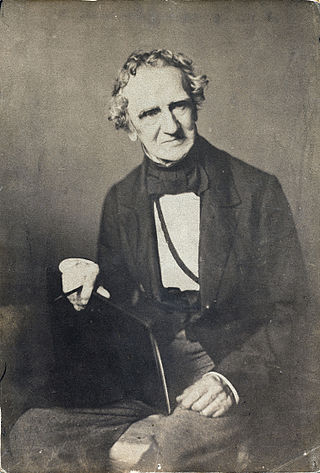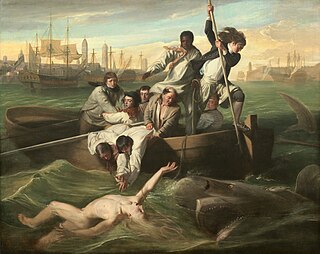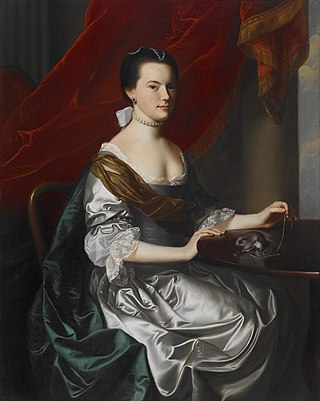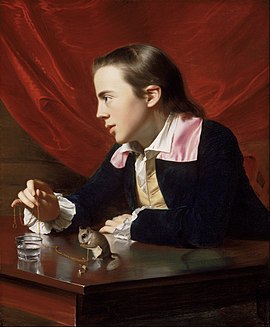
Visual art of the United States or American art is visual art made in the United States or by U.S. artists. Before colonization, there were many flourishing traditions of Native American art, and where the Spanish colonized Spanish Colonial architecture and the accompanying styles in other media were quickly in place. Early colonial art on the East Coast initially relied on artists from Europe, with John White the earliest example. In the late 18th and early 19th centuries, artists primarily painted portraits, and some landscapes in a style based mainly on English painting. Furniture-makers imitating English styles and similar craftsmen were also established in the major cities, but in the English colonies, locally made pottery remained resolutely utilitarian until the 19th century, with fancy products imported.

John Singleton Copley was an Anglo-American painter, active in both colonial America and England. He was probably born in Boston, Province of Massachusetts Bay, to Richard and Mary Singleton Copley, both Anglo-Irish. After becoming well-established as a portrait painter of the wealthy in colonial New England, he moved to London in 1774, never returning to America. In London, he met considerable success as a portraitist for the next two decades, and also painted a number of large history paintings, which were innovative in their readiness to depict modern subjects and modern dress. His later years were less successful, and he died heavily in debt. He was father of John Copley, 1st Baron Lyndhurst.

Gilbert Charles Stuart was an American painter from Rhode Island Colony who is widely considered one of America's foremost portraitists. His best-known work is an unfinished portrait of George Washington, begun in 1796, which is sometimes referred to as the Athenaeum Portrait. Stuart retained the portrait and used it to paint scores of copies that were commissioned by patrons in America and abroad. The image of George Washington featured in the painting has appeared on the United States one-dollar bill for more than a century and on various postage stamps of the 19th century and early 20th century.

Thomas Sully was an American portrait painter in the United States. Born in Great Britain, he lived most of his life in Philadelphia, Pennsylvania. He painted in the style of Thomas Lawrence. His subjects included national political leaders such as United States presidents: Thomas Jefferson, John Quincy Adams, and Andrew Jackson, Revolutionary War hero General Marquis de Lafayette, and many leading musicians and composers. In addition to portraits of wealthy patrons, he painted landscapes and historical pieces such as the 1819 The Passage of the Delaware. His work was adapted for use on United States coinage.

John Smibert was a Scottish-born painter, regarded as the first academically trained artist to live and work regularly in British America.

Mather Brown was an American painter who was born in Boston, Massachusetts and was active in England.

Robert Feke was an American portrait painter born in Oyster Bay, New York. According to art historian Richard Saunders, "Feke’s impact on the development of Colonial painting was substantial, and his pictures set a new standard by which the work of the next generation of aspiring Colonial artists was judged." In total, about 60 paintings by Feke survive, twelve of which are signed and dated.

Henry Inman was an American portrait, genre, and landscape painter.

Watson and the Shark is an oil painting by the American painter John Singleton Copley, depicting the rescue of the English boy Brook Watson from a shark attack in Havana, Cuba. Copley, then living in London, painted three versions. The 1778 version is in the National Gallery of Art, Washington, D.C. A second, full-size 1778 replica is now in the Museum of Fine Arts, Boston, and a third, smaller, 1782 version with a more vertical composition is in the Detroit Institute of Arts.

The Defeat of the Floating Batteries at Gibraltar is the title of a 1791 oil-on-canvas painting by Boston-born American artist John Singleton Copley. It depicts the defeat of the floating batteries at Gibraltar during the Great Siege of Gibraltar. The Governor of Gibraltar, General George Augustus Eliott, is on horseback pointing to the rescue of the defeated Spanish sailors by the British.

Peter Pelham was an American portrait painter and engraver, born in England.

Henry Pelham was an American painter, engraver, and cartographer active during the late 18th century. Pelham's many illuminating letters, especially to his half-brother John Singleton Copley, provide an important contemporary perspective of the events of the American Revolution.
Joseph Badger was a portrait artist in Boston, Massachusetts, in the 18th century. He was born in Charlestown, Massachusetts, to tailor Stephen Badger and Mercy Kettell. He "began his career as a house-painter and glazier, and ... throughout his life continued this work, besides painting signs, hatchments and other heraldic devices, in order to eke out a livelihood when orders for portraits slackened." In 1731 he married Katharine Felch; they moved to Boston around 1733. He was a member of the Brattle Street Church. He died in Boston on May 11, 1765, when "on Saturday last one Mr. Badger, of this Town, Painter, was taken with an Apoplectic Fit as he was walking in his Garden, and expired in a few Minutes after." Works by Badger are in the collections of the Worcester Art Museum, the Museum of Fine Arts Boston, and Historic New England's Phillips House, Salem, Mass. While respected in his own time, subsequent scholars and connoisseurs largely overlooked Badger's significance until Lawrence Park wrote a book about him in 1918.

Elizabeth Okie Paxton (1878–1972) was an American painter, married to another artist William McGregor Paxton (1869–1941). The Paxtons were part of the Boston School, a prominent group of artists known for works of beautiful interiors, landscapes, and portraits of their wealthy patrons. Her paintings were widely exhibited and sold well.

William Johnston was a colonial American painter. He was the first painter to spend any significant amount of time in the Connecticut Colony, and was active in Portsmouth, Province of New Hampshire, as well.
Bertha Coolidge (1880–1953) was an American painter of portrait miniatures.

Mrs. Theodore Atkinson Jr. is an oil-on-canvas portrait painting completed in 1765 by the American artist John Singleton Copley. It is now housed in the Crystal Bridges Museum of American Art.

The Death of General Montgomery in the Attack on Quebec, December 31, 1775 is an oil painting completed in 1786 by the American artist John Trumbull. It depicts American general Richard Montgomery at the Battle of Quebec during the invasion of Quebec. The painting is on view at the Yale University Art Gallery in New Haven, Connecticut. It is the second in Trumbull's series of national historical paintings on the American Revolutionary War, the first being The Death of General Warren at the Battle of Bunker's Hill, June 17, 1775.
Mary Singleton Copley Pelham was an Irish-American colonial settler. Her son was the artist John Singleton Copley. She operated a tobacco retail and wholesale business and taught education, art, and manners classes. By 1751, she had been widowed twice. Her sons, John Singleton Copley and Henry Pelham were accomplished artists. She was step-mother to her second husband, Peter Pelham's five children.


















